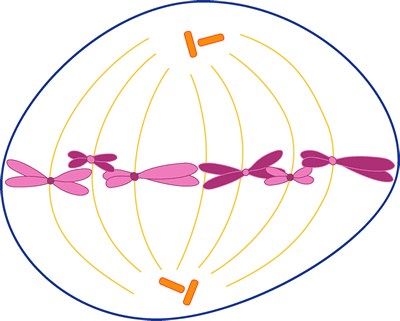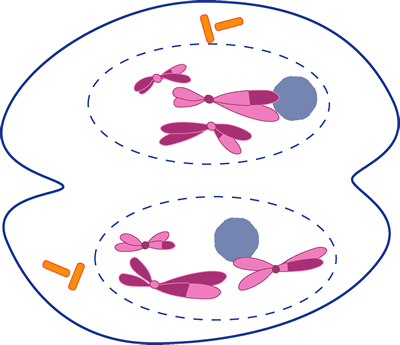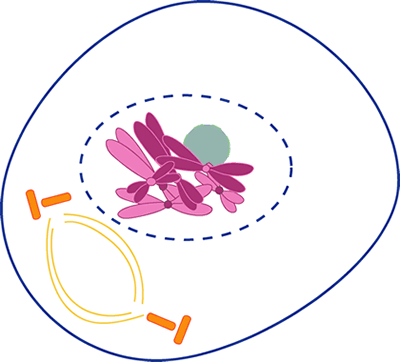Genetic Science Learning Center
http://gslc.genetics.utah.edu/units/cloning/
Open the link and view each of the sections under "Cloning in Focus". For each section, answer the question.
What is Cloning?
1. Who is Dolly?
2. When a zygote divides into to separate cells, it is called:
3. Somatic cells are also called...
4. In order to clone a gene, a gene is inserted into the
5. In order to create an embryo from a somatic cell, the donor egg cell must have its ___________________ removed.
nucleus
Click and Clone
6. List all the materials needed to clone a mouse.
Microscope
7. Place the following steps in the correct order.
1. Isolate donor cells from egg donor and germ cell donor
2. Remove and discard the nucleus from the egg cell
3. Transfer the somatic cell nucleus into the egg cell
4. Stimulate cell division
5. Implant embryo into a surrogate mother
6. Deliver baby
8. There are two time gaps in the process of cloning. What are they? (ie. what do you have to wait for?)
9. What color with the cloned mouse be? _____________ What is the name of this mouse?
Why Clone?
10. Why is cloning extinct animals problematic?
11. What are some reasons a person might want to clone a human?
The Clone Zone
12. What animal was cloned in 1885? _______________________
13. How did Spemann separate the two cells of the embryo of a salamander in 1902? _______________________
14. The process of removing a nucleus is called ________________________
15. In 1952, the nucleus of a tadpole embryo cell was placed into a donor cell. Did it work to clone the animal? ____________ yes
16. Can the nucleus of an adult cell be injected into an egg cell and produce a clone? ___________
17. Why are mammals hard to clone? ______________________________________________
19. In what year was the National Bioethics Advisory Council formed? ______________________
20. The first mammal clone to be produced from an adult (somatic) cell? ____________________________
21. What do scientists do to adult cells to make them "behave" like embryos? _____________________________________
22. Transgenic, cloned sheep were used to produce what medical protein? ______________________________
23. What is a stem cell? ________________________________________________
Cloning Myths
24. Briefly describe in your own words, why CC the cat was not identical in color to Rainbow, even though she was a clone/
25. What is "nature vs nurture"?
The argument that while two people can be genetically identical, the epigenetic factors will always be different in some form.
Is it Cloning or Not?
26. For each of the following scenarios, indicate YES (it is cloning) or NO (it is not cloning)
NO Sperm taken from a mole goat is combined with a female's egg in a petri dish. The resulting embryo is implanted into the female's uterus to develop
YES A sheep embryo, composed of 16 cells, is removed from the mother's uterus and separated into indivudal cells. Each cell is allowed to multiply, creating 16 separate embryos, which are then implanted in different female sheep to develop to maturity.
NO A cow with many desirable traits is stimulated with hormones to produce a number of egg cells. Each of these eggs is fertilized and implanted into a surrogate mother.
NO In vitro fertilization
YES Cell nuclei from an extinct wolly mammoth are placed into enucleated cow cells.
27. Define or describe each of the following processes (you may need to reset the Cloning or Not Screen)
Invitro fertilization
In vitro fertilization is the fusion of a father's sperm with a mother's egg, therefore allowing the child to be unique.
Embryo splitting
All of the original 16 cells came from a single somatic cell on a certain sheep embryo and were separated into different mother surrogates, resulting in cloning.
Somatic Cell Nuclear Transfer
All of the offspring would be the same genetically because the cells have the same genes and will form an identical clone.
Multiple Ovulation Embryo Transfer
Taking donor egg cells and fertilizing them with male sperm is not cloning because none of the offspring would be identical.
Artificial Insemination
Each sperm is different as well as each cow, and this results as not cloning because all the cows birthed are different.
What Are the Risks of Cloning?
28. What is one reason why cloning animals has such a high failure rate?
Sometimes the nucleus isn't compatible with the enucleated egg
29. What is a telomere and how does it affect cloned animals?
Telomeres are DNA sequences at each end of a chromosome. As cells divide, telomeres can become longer or shorter. This is what occurs with clones and their telomeres. They can become longer or shorter, such as Dolly the sheep.
What Are Some Issues in Cloning?
30. Pick one of the questions to ponder and ....ponder it. Write a brief essay on your thoughts and opinions.



